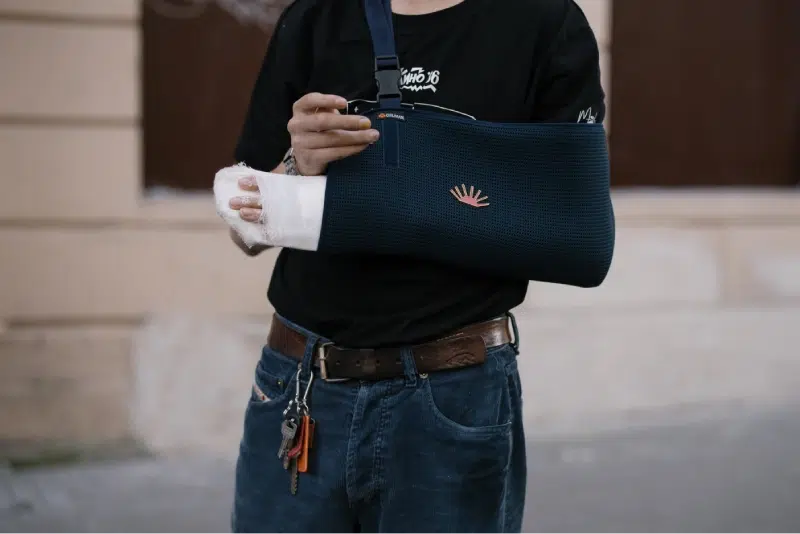A tenant who suffers a personal injury may be entitled to recover damages from their landlord. Tenant personal injuries are not only physical harm but may also include emotional harm. A tenant’s personal injury can happen in many ways: fire in the building, a fall on dilapidated steps, lead or mold exposure, carbon monoxide exposure, vermin or insect infestation, faulty repairs, and criminal conduct, such as rape, assault, and robbery.
Most tenant personal injury claims stem from the implied warranty of habitability. Landlords that are absent, unresponsive, and unconcerned over the safety of their buildings can put tenants in dangerous situations that may cause injuries. The Court has held that all residential rental agreements contain an “implied warranty of habitability”, which means that regardless of what your lease says, your landlord has a duty to ensure the property is livable, safe, and not in need of repair. Green v. Superior Court, 10 Cal. 3d 616 (1974). Landlords are required to make all necessary repairs to ensure a rental unit is habitable and to comply with state and local building and health codes. Cal. Civ. Code § 1941. And in some instances, landlords are not only responsible for their own actions and inaction but may also be responsible for the actions of another tenant, manager, trespasser, or guest. Cal. Civ. Code § 1714.
To be considered habitable, rental units must have effective waterproofing and weather protection; plumbing, gas, electricity, and electrical wiring and equipment in good working order; hot and cold water; adequate heat; all areas maintained free of garbage, rodents, and vermin; floors, stairways, and railings that are in good repair; and adequate garbage receptacles. Cal. Civ. Code § 1941.1. Failure to maintain the property according to these standards often results in conditions that can cause a tenant to become injured.
When is a landlord liable for a tenant’s personal injury?
The legal principal that holds a person accountable for harm to another person is called negligence. For a landlord to be held responsible for an injury to a tenant on the premises, the landlord must have been negligent in caring for the property, and their negligence must have caused the tenant’s injury. To prove a claim for negligence, a tenant must show the following:
- The landlord had a duty to reasonably maintain the property;
- The landlord knew or should have known of the dangerous condition;
- The landlord breached their duty by failing to repair/fix the dangerous condition;
- The landlord’s breach caused the tenant to suffer an injury;
- The plaintiff suffered actual damages.
Does a landlord have a duty to inspect?
A landlord’s lack of knowledge of a dangerous condition is not a defense. Portillo v. Aiassa, 27 Cal. App. 4th 1128, 1134 (1994). A landlord must conduct reasonable periodic inspections of the common areas of a rental property during a tenancy. CACI 1006. Whenever a unit is vacant, a landlord must inspect the unit itself and all common areas for unsafe conditions. Id. This duty to inspect includes taking reasonable precautions to prevent injury. Id. A landlord has a duty to repair conditions that a landlord knows about or reasonably should have known about. Id. Once a tenant is in possession, a landlord must take reasonable precautions to prevent injury due to any unsafe conditions in areas under the tenant’s control if the landlord had actual knowledge of the condition. Id.
How long does a landlord have to repair a dangerous condition?
The landlord is allowed a reasonable amount of time to discover a dangerous condition and to repair it. To be held liable for a tenant’s personal injuries, a landlord need only know about a dangerous condition for so long as it would have taken to (1) repair the condition; or (2) protect against harm from the condition; or (3) adequately warn of the condition. CACI 1011.
Can a landlord be held liable for a tenant’s personal injury caused by their employee or agent?
Yes. A landlord can be held liable for injuries caused by a landlord’s employee, contractor, repairmen, worker, or manager. Srithong v. Total Investment Co., 23 Cal. App. 4th 721, 726 (1994). The duty to repair is non-delegable, meaning that a landlord is liable for personal injuries caused by the refusal or failure of an agent to repair a dangerous condition. Id. If an employee or agent of the landlord created or knew of a dangerous condition, then it is presumed that the landlord knew of the dangerous condition. CACI 1012.
What are some common dangerous conditions that could cause a tenant to become injured?
Stairs: Buildings can have interior and exterior stairs. Broken railings and steps, loose banisters, and deteriorated carpeting all can cause accidents. Landlords are required to make sure the stairs are safe for tenants to use. Cal. Civ. Code § 1941.1
Walkways, driveways, garages: Walkways, parking lots, and driveways are often neglected and may develop cracks in the pavement, potholes, or become uneven over time, which can create a risk of falling or tripping. These areas are part of the property and must also be adequately maintained by the landlord. A landlord must maintain sidewalks, driveways, garages, and abutting streets in safe condition to prevent potential tenant personal injury. CACI 1007 and Swanberg v. O’Mectin, 157 Cal. App. 3d 325, 330 (1984).
Decks and balconies: Balconies and decks can become water damaged or generally dilapidated, which can place the structure at risk of collapsing. A new law went into effect in 2019 in response to a recent and serious accident that involved a collapse of a residential rental unit balcony in the San Francisco Bay Area. Landlords are now required to complete a safety inspection on decks and balconies that are more than six feet above the ground in properties that have three or more units. Cal. Health and Safety § 17973. The initial inspection must be completed by 2025, with subsequent inspections done very six years. The inspection must be done by a licensed architect, engineer, or contractor. Id.
Floors: Dilapidated flooring, loose floorboards and tile, and ripped carpeting can all pose tripping hazards. Landlords are required to make sure the floors are safe for tenants to use. Cal. Civ. Code § 1941.1
Fire: Fires in a building can begin for many reasons. One issue in buildings that contribute to injuries due to a fire is that a tenant may not get adequate warning to evacuate. Missing or non-operable smoke alarms can result in deaths from fire and smoke inhalation. Smoke alarms must be installed inside each bedroom. Cal. Health and Safety Code § 13113.7. New construction and remodels require new smoke and carbon monoxide detectors to be hardwired to the home’s electric system and have a battery backup and an interconnecting alarm. Id. For older properties that cannot install hardwire devices, smoke and carbon monoxide detectors must contain a non-removable battery that can last ten years. Id. Whenever permits for improvements or repairs over $1000 are made, the permit cannot be obtained for that work until the permittee also demonstrates that existing smoke detector devices are in compliance. Id.
Lead: Tenants can be exposed to lead from chipped or peeling paint, and they may, especially children, suffer severe physical and developmental injuries as a result. The Federal Residential Lead-Based Paint Hazard Reduction Act of 1992 requires disclosure of possible lead to tenants. In properties built before 1978, the landlord must give prospective tenants a written Disclosure of Information on Lead-Based Paint and/or Lead-Based Paint Hazards. The landlord must disclose the presence of known lead-based paint and related hazards in the unit before the tenant signs the lease.
Mold: Long-term exposure to certain molds can pose a threat to a tenant’s health. Over time, a tenant may develop symptoms such as persistent wheezing and/or coughing, nosebleeds, rashes, and neurological issues. When a landlord knows or has reason to know that mold in the unit exceeds permissible exposure limits or poses a health threat, the landlord is required to give tenants a written disclosure before they sign the lease. Cal. Health and Safety Code § 26147. Properties with visible mold growth that endangers a tenant’s health will be deemed as substandard housing. Cal. Health and Safety § 17920.3. In some jurisdictions, such as San Francisco, mold is considered a “public health nuisance.” S.F. Cal. Health and Safety Code § 581(a)(6).
Onsite playgrounds: Playgrounds that are onsite at multi-unit complexes are part of the common areas under the landlord’s control that must be maintained in good repair and safe to use. Improperly assembled, deteriorated, neglected, and poorly maintained playground equipment could result in serious risk of injury to children. Unsafe surfacing that does not adequately cushion a fall can also put a tenant at risk of serious injury.
Crime: Rental properties must be secure and safe. Landlords have a duty to take reasonable steps to protect tenants from the foreseeable criminal acts of another. Cal. Civ. Code § 1714. Criminal acts can include assault, battery, robbery, murder, rape, and property damage. When a landlord fails to use reasonable care to protect their tenants, they can be held liable for the negligent or intentional criminal conduct of a third party. Caci No. 1005. Properly secured doors that prohibit non-tenant strangers from entering a rental property are essential to keeping tenants safe. California law requires landlords to equip doors that provide an ingress and egress to the common areas with “locking mechanisms that comply with applicable fire and safety codes.” Cal. Civ. Code § 1941.3. Depending on the neighborhood the property is located and what types of crime are likely to occur, other security measures could include extra lighting, motion sensitive lighting, locked outside security gates at the entrance and exit to the property, and video surveillance and cameras.
Dog bites: Under some circumstances, a landlord can be held liable when a tenant’s dog bites another person, including another tenant. The landlord has no duty to inspect the premises to ascertain that the animal exists, but if the landlord knows that the dog is present on the property and knows that it has dangerous propensities, the landlord could be held liable for the personal injuries resulting from it biting someone. Uccello v. Laudenslayer, 44 Cal. App. 3d 504, 514 (1975). If a landlord has actual knowledge of a vicious animal on the property they should take steps to have the animal removed, which can include eviction of the dog-harboring tenant. Id.
What damages can a tenant who has suffered a personal injury recover from a landlord?
A tenant who has suffered a personal injury due to their landlord’s negligence may be entitled to an award for their medical bills, lost wages, pain and suffering, disability or disfigurement, emotional distress, and personal property damage. Depending on the case, treble damages, punitive damages, and future damages could also be awarded.
Because there is a statute of limitations (i.e. a time limit for bringing a lawsuit against the landlord) for the different types of claims that could arise from a tenant being injured on the rental property, an injured tenant should consult with a tenant attorney as soon possible.
If you are a tenant that has suffered a personal injury due to your landlord’s negligence, call Tobener Ravenscroft LLP to speak to a tenant attorney about your rights.




